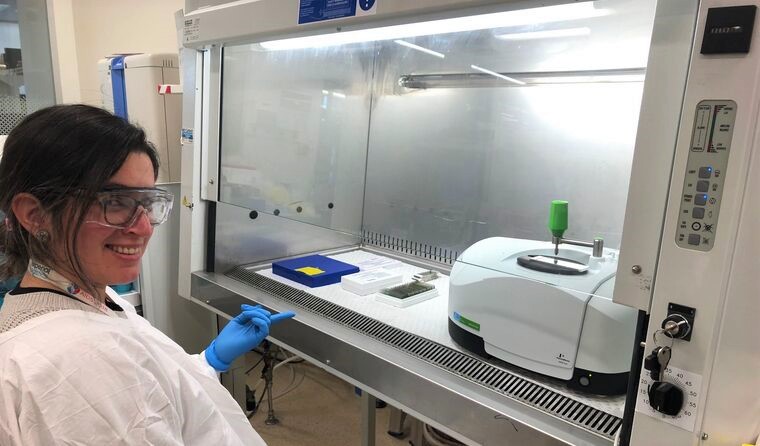News
New saliva test has potential to detect COVID-19 in five minutes
It’s considered a next generation approach to testing and could further assist in minimising the risks of viral spread.
 The new saliva screening test uses infrared light technology. (Image: AAP)
The new saliva screening test uses infrared light technology. (Image: AAP)
Turnaround time for COVID test results in Australia has shortened significantly, averaging between 1–2 days. But what if that could be cut down to just five minutes?
That could very well be case, thanks to new preliminary research into a saliva screening test that uses infrared light technology.
Researchers from Monash University and the Doherty Institute have identified a SARS-CoV-2 RNA signature in the infrared spectra of saliva from 27 out of the 29 samples of people who presented at the Royal Melbourne Hospital with COVID-19-like symptoms, and recorded using a portable infrared spectrometer.
‘The test basically uses an infrared light source. It shines it on the sample and, depending on what’s in the sample, you get a different emission from that sample,’ study co-author Professor Dale Godfrey told newsGP.
‘So there’s a signature of light that comes off the sample when it’s hit by the infrared beam, and that signature will tell you, for example, [whether you] have … particular molecules present that are characteristic of the SARS-CoV-2 virus.
‘The virus has a certain pattern of molecules that you can detect based on what comes off this sample when you hit it with this infrared light beam.’
The infrared spectrometer was modified to enable high throughput screening, enabling the samples to be rapidly scanned in a contactless mode, without having to clean the instrument between measurements.
Using this technique, it is estimated up to 5000 samples per instrument could be screened per day with results for each being ready in a matter of minutes.
If the screening test hits the market, Professor Godfrey says, it would be highly advantageous.
‘People … might hesitate to go and get a test because it’s just a bit of a bit too much of a hassle and a time delay,’ he said.
‘This could make things a bit easier – and that’s the point. It’s a completely different kind of test that can be done quickly and efficiently.’

Dr Natalia Salazar-Quiroz, formerly from the Doherty Institute and a co-author of the paper, pictured with the screening instrument used to detect SARS-CoV-2. (Image: Supplied/Professor Bayden Wood)
The test is also portable, meaning it could be done in any setting where testing is required, including airports, hotel quarantine, educational facilities and sporting venues, to help further control the virus’ spread and protect the community.
‘We could have a testing station where you turn up, they take a sample, they put it on the machine and five minutes later they say, “You’re okay”, or they might say “You need to get further PCR-based testing”,’ Professor Godfrey said.
‘So it could be implemented anywhere where people are needing to get COVID tests, with the main advantage being you get a faster answer.
‘So really there’s no limit as to where it could potentially be used, except for the fact that it needs this instrument to be positioned wherever you want to do the testing.’
A similar infrared technique, attenuated total reflectance (ATR) spectroscopy, has been used by the study’s researchers from Monash University to successfully detect other diseases, such as malaria and hepatitis.
But compared to the traditional ATR technology, the new transflection infrared-based approach adapted for COVID has triple the absorbance and is able to interrogate more saliva to detect pathogens.
Currently in the proof-of-concept stage, the test was found to have a sensitivity of 93%, and a specificity of 82%. To further validate it, the team is now looking to get ahold of new COVID samples to expand testing, and international collaborators are also starting to look at testing the approach.
If further research shows the test is reliable, could it replace PCR testing? Professor Godfrey says it is too early to say.
‘This is the first paper, we think, of many that will continue to demonstrate the potential use of this approach. The test needs to go through further refining and machine-learning-based programming to work out the best way to tell a positive from a negative sample,’ he said.
‘By the time we’ve tested 3000 samples, we should have a very good idea if this is as good as PCR testing or not.
‘So, ultimately, this could replace PCR testing, but I think it’s too early to say if that’s likely to be the case. We would hope that this could, at the very least, act as a pre-screening mechanism for determining who should go through further testing for PCR analysis.’
While it is not yet clear when the test could become available, Professor Godfrey says the pandemic has demonstrated just how fast new developments can evolve.
‘Ordinarily, this would be expected to be a matter of a year or more,’ he said.
‘But in the context of COVID, where new kinds of tests will be hugely beneficial, it could happen within a year – it might even be months. But I wouldn’t want to stick my neck out too far to say that; it’s better to be a bit cautious about these things.
‘This is potentially a next generation testing approach. We have great hope that it might ultimately make a big difference in efficiency of COVID testing.’
Log in below to join the conversation.
COVID-19 infection control PCR testing saliva test
newsGP weekly poll
Health practitioners found guilty of sexual misconduct will soon have the finding permanently recorded on their public register record. Do you support this change?